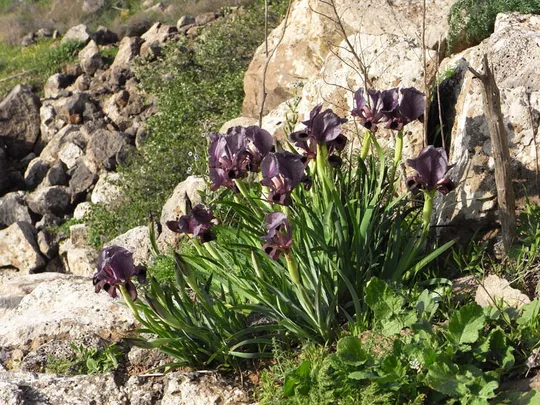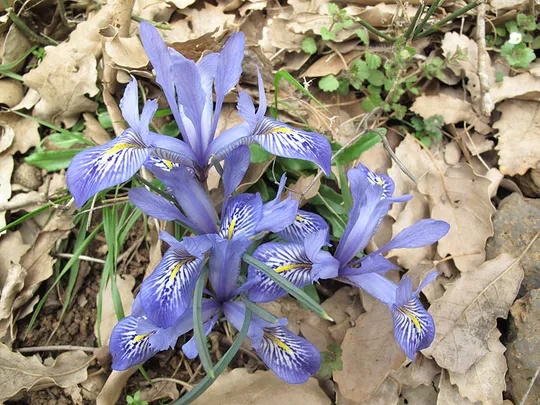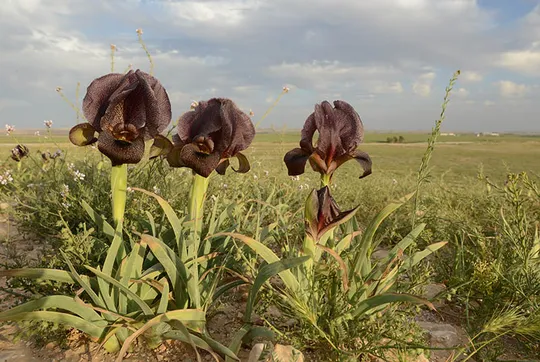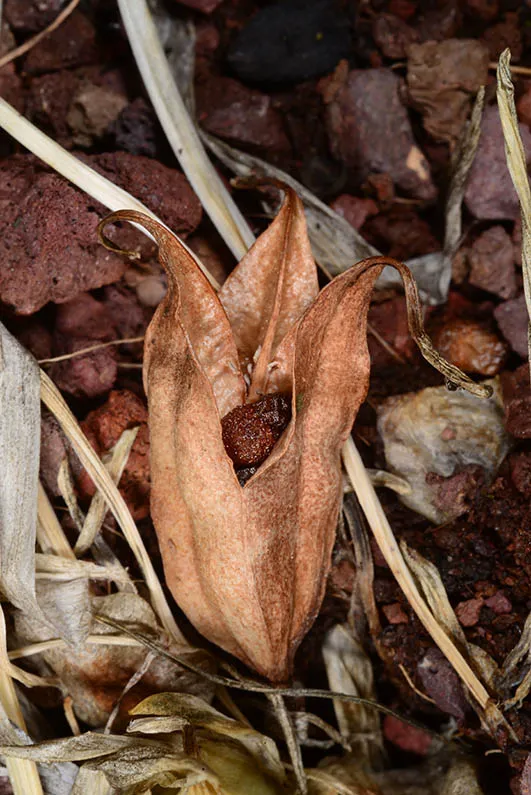Tuvia's Iris, King Uzziae Iris
Iris regis-uzziae
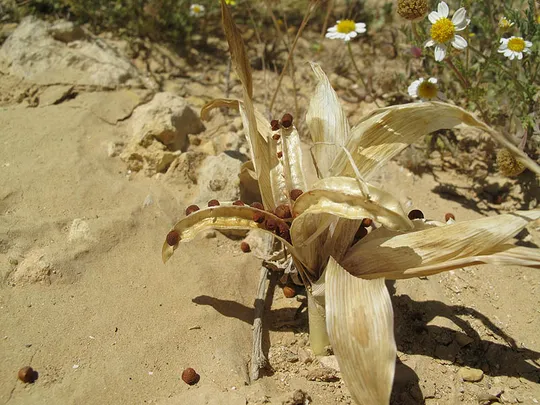
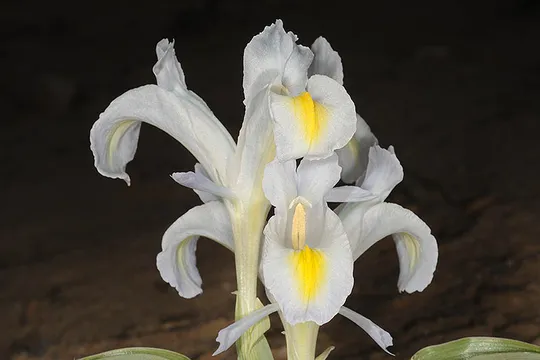

Iris regis-uzziae is a 17-25 cm tall bulb geophyte. Its light-green leaves are straight and slightly shiny. The cross-section of the leaf is grooved. There are two white lines along the edges of the leaf – an excellent identification sign. The flower is whitish to azure, with a characteristic iris shape: three inner narrow perianth segments – "flags", and three lower outer perianth segments – "lips". The lip is longer than the other parts of the flower, and has a yellow, elongated patch at it center on a bluish background. The three pistils are broad and petal-like and each of them forms an upper lip, which, together with the lip, forms an independent flowering unit for visiting bees. There is one stamen in each flowering unit. I. regis-uzziae blooms in late February to early March, and on the Negev Highlands peaks in early April.
Its distribution is
limited to the northern Negev Mountains and to the Negev Highlands: from the
ridges surrounding the HaMakhtesh HaGadol, Mount Boker, Ramat Ovdat and the
entire Negev Highlands to the Lots Cisterns, Mount Arif and south to Mount
Sagi. Marginal populations of the Negev Highlands core populations exist in a
few locations in the southern Negev at the edge of the Negev Highlands (in the
area of Mount Ido, Wadi Saraf and Wadi Hagor).
Rocky limestone slopes
with rocky ledges at altitudes above 450 (350) m in the northern Negev. At
higher altitudes within the rocky habitat, with its improved water regime,
populations are denser and the individual plants are larger.
The species was first
collected from both Ras a-Naqeb in southern Edom and from the Negev Highlands. Feinbrun
described it in 1978 and named it after King Uzziah. Recently, the Government Names Committee changed its Hebrew name
to the Tuvia iris after Tuvia Kushnir, who first collected the species in 1943.
The species most similar
to Iris regis-uzziae is Iris palaestina, whose flower color is yellowish-cream.
In the southern Judean Mountains and southern coastal plain, Iris palaestina
has an azure perianth, similar to that of Iris regis-uzziae. Post described
this form as a “bluing” variety of Iris palaestina, but the Iris
expert (Mathew, 1981) believes that this variety is a synonym for another
species, I. postii. Mouterde described Iris postii
by from the transition area of Syria, and according to him, this is a common
species in the Syrian Desert, western Iraq and the Black Desert in eastern
Jordan (Al-Eisawi, 1998). The species was also photographed and collected in
northern Arabia, in particular at the Tovog Heights (950 m), close to the Jordanian
border. The plants from the Tovog Heights are very similar to Iris
regis-uzziae and most probably the distribution of Iris regis-uzziae
extends to northern Arabia.
Iris regis-uzziae is an endemic species, which suggests
the existence of a close biogeographic connection between the Negev Highlands
flora and the flora of Edom. A large group of common relict species grows in
both of these high areas, despite the extreme disjunction between them created
by the Aravah. This disjunction suggests that in the not very distant past
(apparently 15-30,000 years ago), the climate in the area was colder and
rainier, allowing migration of northern flora to Edom and to the Negev
Highlands. During the dry Holocene period, the Negev populations separated from
the original populations (Iris palaestina) and underwent speciation.
·
It is important to preserve
the Negev Highland populations between Ovdat and upper Wadi Tsin. In this region,
there are many populations which could become extinct while land is being
developed, as occurred when the airfield was established at Ramat Matred
·
The plants grow between
rocks. Usually, they do not form clumps, which suggest that their vegetative
reproduction is weak. There is usually
not much fragmentation between populations.
·
The population size has not
changed from the past, because the earthworks and development of settlements in
the northern Negev have not affected the populations to date. There are large
annual fluctuations in the abundance of the populations and the number of their
flowers, a phenomenon apparently related to fluctuations in the annual
precipitation in the desert.
·
The populations in Jordan
are very rare and appear in patches. They are not protected at all.
·
Protected at the Lots
Cisterns in the Negev Highlands Reserve.
If development activity increases
in the Negev, threatened plants should be translocated to the Negev Highlands
Reserve.
The species is endemic
to the Negev Highlands in Israel and to Edom and Moab in southern Jordan. In Jordan,
it grows only on the upper calcareous ridge (A-Shara formation) at altitudes of
1350-1750 m, from Ras a-Naqeb in the south to the Tafila Mountains in the
north. A few plants were also found in the southern Moab Heights.
A
geophyte endemic to the Negev Highlands, Edom and Moab. A young species, which
apparently speciated from Iris palaestina. In most of the sites, it is
not endangered, but development activity in the Negev Highlands is liable to threaten
its populations.
Current Occupancy Map
| 1000 squre meter pixel | 5000 squre meter pixel | 10000 squre meter pixel | |
|---|---|---|---|
| number of observations | 0 | 0 | 0 |
| in total pixels | 0 | 0 | 0 |
| Family | Iridaceae |
| Classification | On the endangered species list |
| Ecosystem | Desert Mountains |
| Chorotype | Endemic: Western Irano-Turanian |
| Conservation Site | Lutz Pits and Upper Nahal Tsin in the Negev Mountain Reserve |
| Rarity |
1
1
6
|
|---|---|
| Vulnerability |
0
0
4
|
| Attractiveness |
0
2
4
|
| Endemism |
0
3
4
|
| Red number |
1
3.2
10
|
| Peripherality | 0 |
| IUCN category | DD EW EX LC CR EN VU NT |
| Threat Definition according to the red book | Vulnerable |
 Based on:
Based on:
